INF80025: Analysis of Business Systems at Clinical Healthcare Inc.
VerifiedAdded on 2023/06/12
|12
|3137
|178
Report
AI Summary
This report provides a comprehensive analysis of business information systems analysis and design methodologies, focusing on both hard and soft systems thinking. It begins by summarizing a paper on the socio-technical toolbox and its application to organizational change. The report then delves into specific methodologies, including Soft Systems Methodology (SSM), ETHICS (Effective Technical and Human Implementation of Computer-based Systems), and Agile systems development, highlighting their strengths and weaknesses. A critical comparison of hard and soft systems thinking is presented, defining how each approaches problem identification and resolution. The report further explores how each methodology relates to hard and soft system problems, using Clinical Healthcare Inc. as a case study to illustrate practical applications. The document concludes by evaluating the effectiveness of SSM, ETHICS, and Agile systems development in addressing complex organizational challenges.
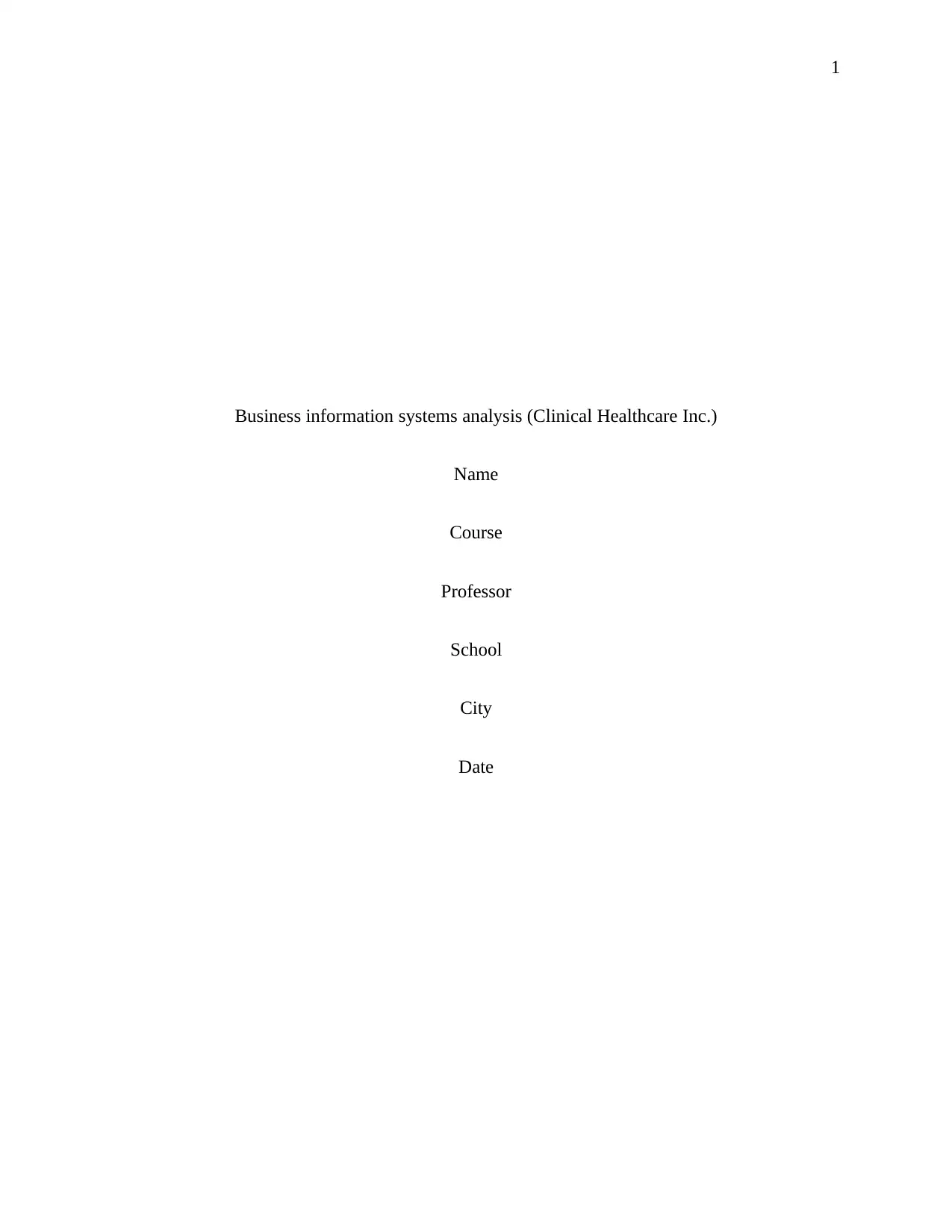
1
Business information systems analysis (Clinical Healthcare Inc.)
Name
Course
Professor
School
City
Date
Business information systems analysis (Clinical Healthcare Inc.)
Name
Course
Professor
School
City
Date
Paraphrase This Document
Need a fresh take? Get an instant paraphrase of this document with our AI Paraphraser
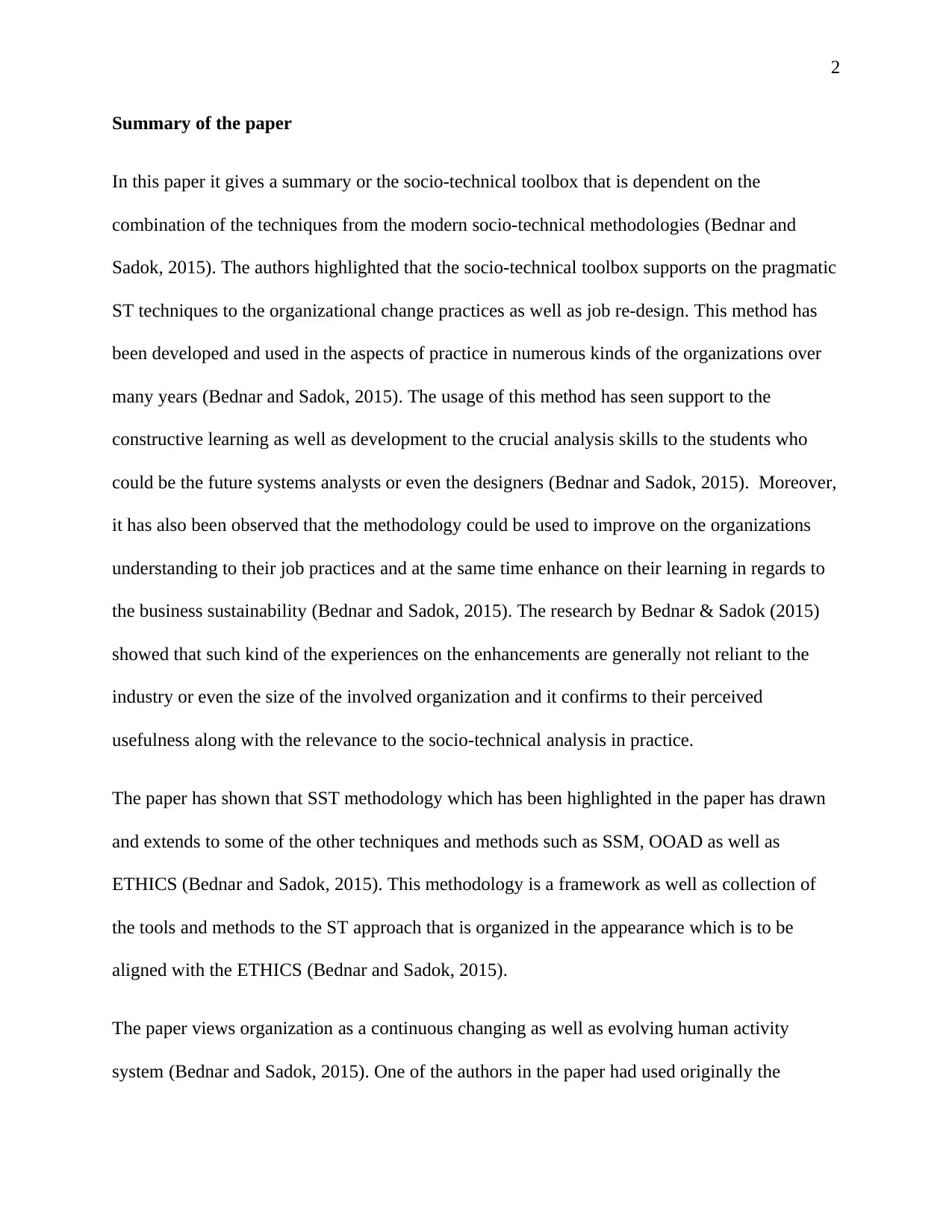
2
Summary of the paper
In this paper it gives a summary or the socio-technical toolbox that is dependent on the
combination of the techniques from the modern socio-technical methodologies (Bednar and
Sadok, 2015). The authors highlighted that the socio-technical toolbox supports on the pragmatic
ST techniques to the organizational change practices as well as job re-design. This method has
been developed and used in the aspects of practice in numerous kinds of the organizations over
many years (Bednar and Sadok, 2015). The usage of this method has seen support to the
constructive learning as well as development to the crucial analysis skills to the students who
could be the future systems analysts or even the designers (Bednar and Sadok, 2015). Moreover,
it has also been observed that the methodology could be used to improve on the organizations
understanding to their job practices and at the same time enhance on their learning in regards to
the business sustainability (Bednar and Sadok, 2015). The research by Bednar & Sadok (2015)
showed that such kind of the experiences on the enhancements are generally not reliant to the
industry or even the size of the involved organization and it confirms to their perceived
usefulness along with the relevance to the socio-technical analysis in practice.
The paper has shown that SST methodology which has been highlighted in the paper has drawn
and extends to some of the other techniques and methods such as SSM, OOAD as well as
ETHICS (Bednar and Sadok, 2015). This methodology is a framework as well as collection of
the tools and methods to the ST approach that is organized in the appearance which is to be
aligned with the ETHICS (Bednar and Sadok, 2015).
The paper views organization as a continuous changing as well as evolving human activity
system (Bednar and Sadok, 2015). One of the authors in the paper had used originally the
Summary of the paper
In this paper it gives a summary or the socio-technical toolbox that is dependent on the
combination of the techniques from the modern socio-technical methodologies (Bednar and
Sadok, 2015). The authors highlighted that the socio-technical toolbox supports on the pragmatic
ST techniques to the organizational change practices as well as job re-design. This method has
been developed and used in the aspects of practice in numerous kinds of the organizations over
many years (Bednar and Sadok, 2015). The usage of this method has seen support to the
constructive learning as well as development to the crucial analysis skills to the students who
could be the future systems analysts or even the designers (Bednar and Sadok, 2015). Moreover,
it has also been observed that the methodology could be used to improve on the organizations
understanding to their job practices and at the same time enhance on their learning in regards to
the business sustainability (Bednar and Sadok, 2015). The research by Bednar & Sadok (2015)
showed that such kind of the experiences on the enhancements are generally not reliant to the
industry or even the size of the involved organization and it confirms to their perceived
usefulness along with the relevance to the socio-technical analysis in practice.
The paper has shown that SST methodology which has been highlighted in the paper has drawn
and extends to some of the other techniques and methods such as SSM, OOAD as well as
ETHICS (Bednar and Sadok, 2015). This methodology is a framework as well as collection of
the tools and methods to the ST approach that is organized in the appearance which is to be
aligned with the ETHICS (Bednar and Sadok, 2015).
The paper views organization as a continuous changing as well as evolving human activity
system (Bednar and Sadok, 2015). One of the authors in the paper had used originally the
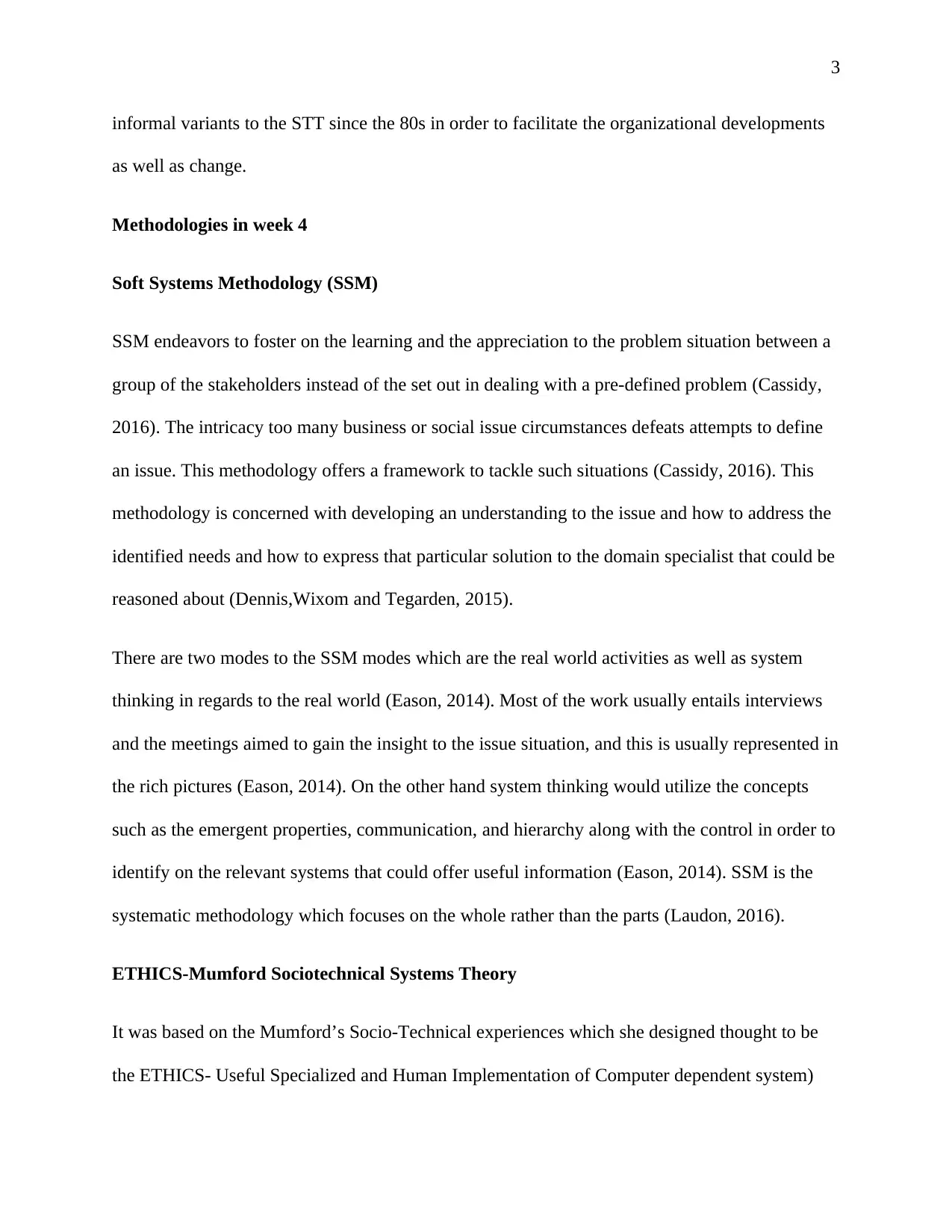
3
informal variants to the STT since the 80s in order to facilitate the organizational developments
as well as change.
Methodologies in week 4
Soft Systems Methodology (SSM)
SSM endeavors to foster on the learning and the appreciation to the problem situation between a
group of the stakeholders instead of the set out in dealing with a pre-defined problem (Cassidy,
2016). The intricacy too many business or social issue circumstances defeats attempts to define
an issue. This methodology offers a framework to tackle such situations (Cassidy, 2016). This
methodology is concerned with developing an understanding to the issue and how to address the
identified needs and how to express that particular solution to the domain specialist that could be
reasoned about (Dennis,Wixom and Tegarden, 2015).
There are two modes to the SSM modes which are the real world activities as well as system
thinking in regards to the real world (Eason, 2014). Most of the work usually entails interviews
and the meetings aimed to gain the insight to the issue situation, and this is usually represented in
the rich pictures (Eason, 2014). On the other hand system thinking would utilize the concepts
such as the emergent properties, communication, and hierarchy along with the control in order to
identify on the relevant systems that could offer useful information (Eason, 2014). SSM is the
systematic methodology which focuses on the whole rather than the parts (Laudon, 2016).
ETHICS-Mumford Sociotechnical Systems Theory
It was based on the Mumford’s Socio-Technical experiences which she designed thought to be
the ETHICS- Useful Specialized and Human Implementation of Computer dependent system)
informal variants to the STT since the 80s in order to facilitate the organizational developments
as well as change.
Methodologies in week 4
Soft Systems Methodology (SSM)
SSM endeavors to foster on the learning and the appreciation to the problem situation between a
group of the stakeholders instead of the set out in dealing with a pre-defined problem (Cassidy,
2016). The intricacy too many business or social issue circumstances defeats attempts to define
an issue. This methodology offers a framework to tackle such situations (Cassidy, 2016). This
methodology is concerned with developing an understanding to the issue and how to address the
identified needs and how to express that particular solution to the domain specialist that could be
reasoned about (Dennis,Wixom and Tegarden, 2015).
There are two modes to the SSM modes which are the real world activities as well as system
thinking in regards to the real world (Eason, 2014). Most of the work usually entails interviews
and the meetings aimed to gain the insight to the issue situation, and this is usually represented in
the rich pictures (Eason, 2014). On the other hand system thinking would utilize the concepts
such as the emergent properties, communication, and hierarchy along with the control in order to
identify on the relevant systems that could offer useful information (Eason, 2014). SSM is the
systematic methodology which focuses on the whole rather than the parts (Laudon, 2016).
ETHICS-Mumford Sociotechnical Systems Theory
It was based on the Mumford’s Socio-Technical experiences which she designed thought to be
the ETHICS- Useful Specialized and Human Implementation of Computer dependent system)
⊘ This is a preview!⊘
Do you want full access?
Subscribe today to unlock all pages.

Trusted by 1+ million students worldwide
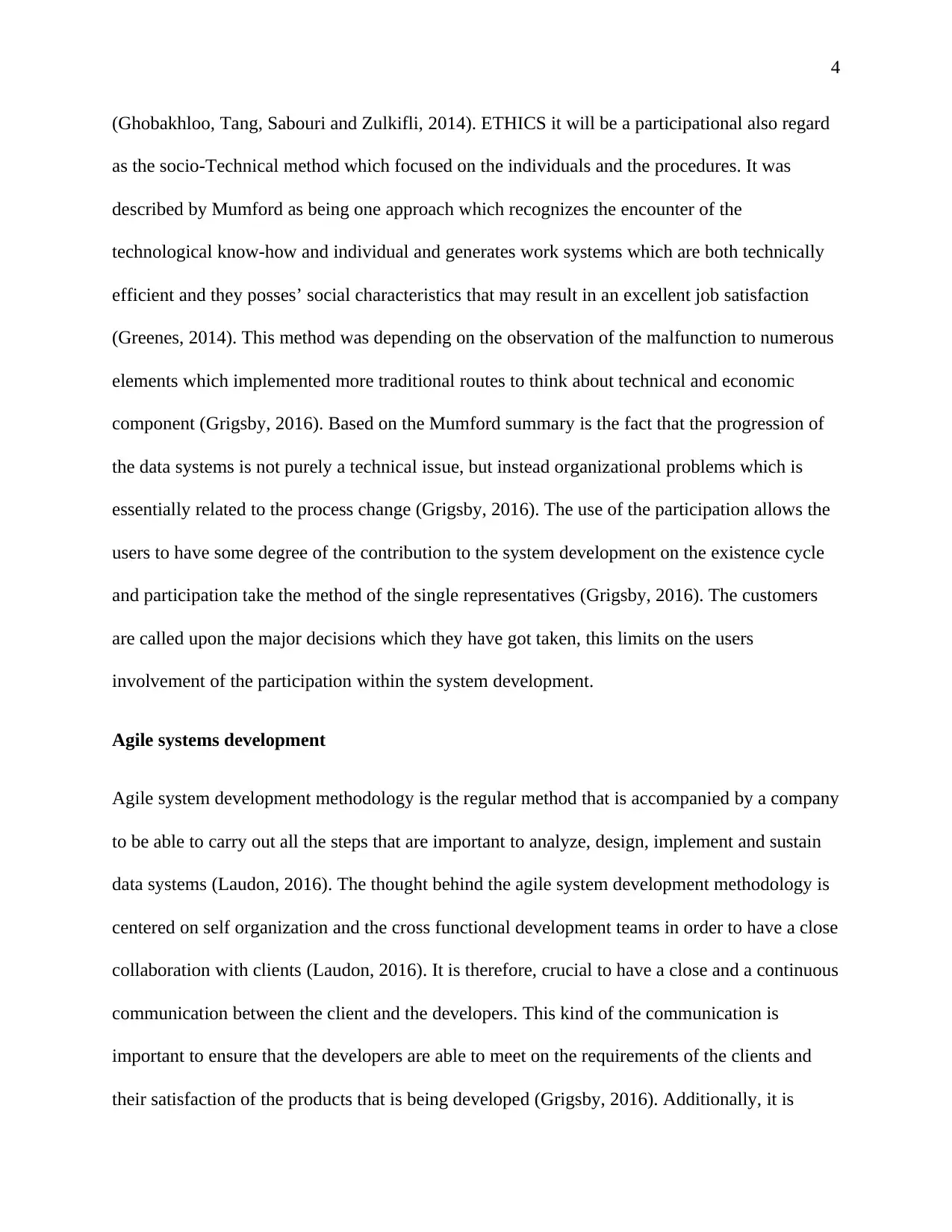
4
(Ghobakhloo, Tang, Sabouri and Zulkifli, 2014). ETHICS it will be a participational also regard
as the socio-Technical method which focused on the individuals and the procedures. It was
described by Mumford as being one approach which recognizes the encounter of the
technological know-how and individual and generates work systems which are both technically
efficient and they posses’ social characteristics that may result in an excellent job satisfaction
(Greenes, 2014). This method was depending on the observation of the malfunction to numerous
elements which implemented more traditional routes to think about technical and economic
component (Grigsby, 2016). Based on the Mumford summary is the fact that the progression of
the data systems is not purely a technical issue, but instead organizational problems which is
essentially related to the process change (Grigsby, 2016). The use of the participation allows the
users to have some degree of the contribution to the system development on the existence cycle
and participation take the method of the single representatives (Grigsby, 2016). The customers
are called upon the major decisions which they have got taken, this limits on the users
involvement of the participation within the system development.
Agile systems development
Agile system development methodology is the regular method that is accompanied by a company
to be able to carry out all the steps that are important to analyze, design, implement and sustain
data systems (Laudon, 2016). The thought behind the agile system development methodology is
centered on self organization and the cross functional development teams in order to have a close
collaboration with clients (Laudon, 2016). It is therefore, crucial to have a close and a continuous
communication between the client and the developers. This kind of the communication is
important to ensure that the developers are able to meet on the requirements of the clients and
their satisfaction of the products that is being developed (Grigsby, 2016). Additionally, it is
(Ghobakhloo, Tang, Sabouri and Zulkifli, 2014). ETHICS it will be a participational also regard
as the socio-Technical method which focused on the individuals and the procedures. It was
described by Mumford as being one approach which recognizes the encounter of the
technological know-how and individual and generates work systems which are both technically
efficient and they posses’ social characteristics that may result in an excellent job satisfaction
(Greenes, 2014). This method was depending on the observation of the malfunction to numerous
elements which implemented more traditional routes to think about technical and economic
component (Grigsby, 2016). Based on the Mumford summary is the fact that the progression of
the data systems is not purely a technical issue, but instead organizational problems which is
essentially related to the process change (Grigsby, 2016). The use of the participation allows the
users to have some degree of the contribution to the system development on the existence cycle
and participation take the method of the single representatives (Grigsby, 2016). The customers
are called upon the major decisions which they have got taken, this limits on the users
involvement of the participation within the system development.
Agile systems development
Agile system development methodology is the regular method that is accompanied by a company
to be able to carry out all the steps that are important to analyze, design, implement and sustain
data systems (Laudon, 2016). The thought behind the agile system development methodology is
centered on self organization and the cross functional development teams in order to have a close
collaboration with clients (Laudon, 2016). It is therefore, crucial to have a close and a continuous
communication between the client and the developers. This kind of the communication is
important to ensure that the developers are able to meet on the requirements of the clients and
their satisfaction of the products that is being developed (Grigsby, 2016). Additionally, it is
Paraphrase This Document
Need a fresh take? Get an instant paraphrase of this document with our AI Paraphraser
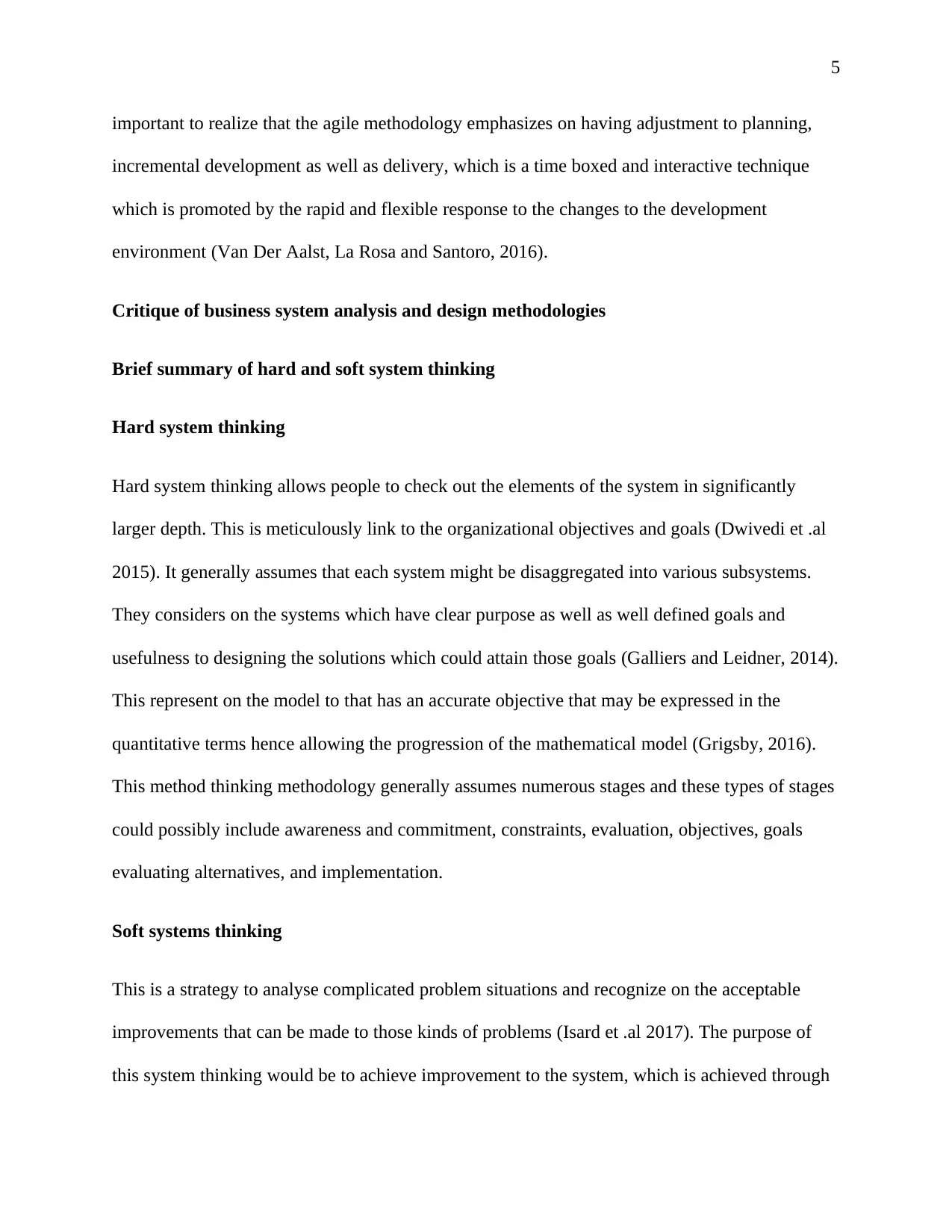
5
important to realize that the agile methodology emphasizes on having adjustment to planning,
incremental development as well as delivery, which is a time boxed and interactive technique
which is promoted by the rapid and flexible response to the changes to the development
environment (Van Der Aalst, La Rosa and Santoro, 2016).
Critique of business system analysis and design methodologies
Brief summary of hard and soft system thinking
Hard system thinking
Hard system thinking allows people to check out the elements of the system in significantly
larger depth. This is meticulously link to the organizational objectives and goals (Dwivedi et .al
2015). It generally assumes that each system might be disaggregated into various subsystems.
They considers on the systems which have clear purpose as well as well defined goals and
usefulness to designing the solutions which could attain those goals (Galliers and Leidner, 2014).
This represent on the model to that has an accurate objective that may be expressed in the
quantitative terms hence allowing the progression of the mathematical model (Grigsby, 2016).
This method thinking methodology generally assumes numerous stages and these types of stages
could possibly include awareness and commitment, constraints, evaluation, objectives, goals
evaluating alternatives, and implementation.
Soft systems thinking
This is a strategy to analyse complicated problem situations and recognize on the acceptable
improvements that can be made to those kinds of problems (Isard et .al 2017). The purpose of
this system thinking would be to achieve improvement to the system, which is achieved through
important to realize that the agile methodology emphasizes on having adjustment to planning,
incremental development as well as delivery, which is a time boxed and interactive technique
which is promoted by the rapid and flexible response to the changes to the development
environment (Van Der Aalst, La Rosa and Santoro, 2016).
Critique of business system analysis and design methodologies
Brief summary of hard and soft system thinking
Hard system thinking
Hard system thinking allows people to check out the elements of the system in significantly
larger depth. This is meticulously link to the organizational objectives and goals (Dwivedi et .al
2015). It generally assumes that each system might be disaggregated into various subsystems.
They considers on the systems which have clear purpose as well as well defined goals and
usefulness to designing the solutions which could attain those goals (Galliers and Leidner, 2014).
This represent on the model to that has an accurate objective that may be expressed in the
quantitative terms hence allowing the progression of the mathematical model (Grigsby, 2016).
This method thinking methodology generally assumes numerous stages and these types of stages
could possibly include awareness and commitment, constraints, evaluation, objectives, goals
evaluating alternatives, and implementation.
Soft systems thinking
This is a strategy to analyse complicated problem situations and recognize on the acceptable
improvements that can be made to those kinds of problems (Isard et .al 2017). The purpose of
this system thinking would be to achieve improvement to the system, which is achieved through
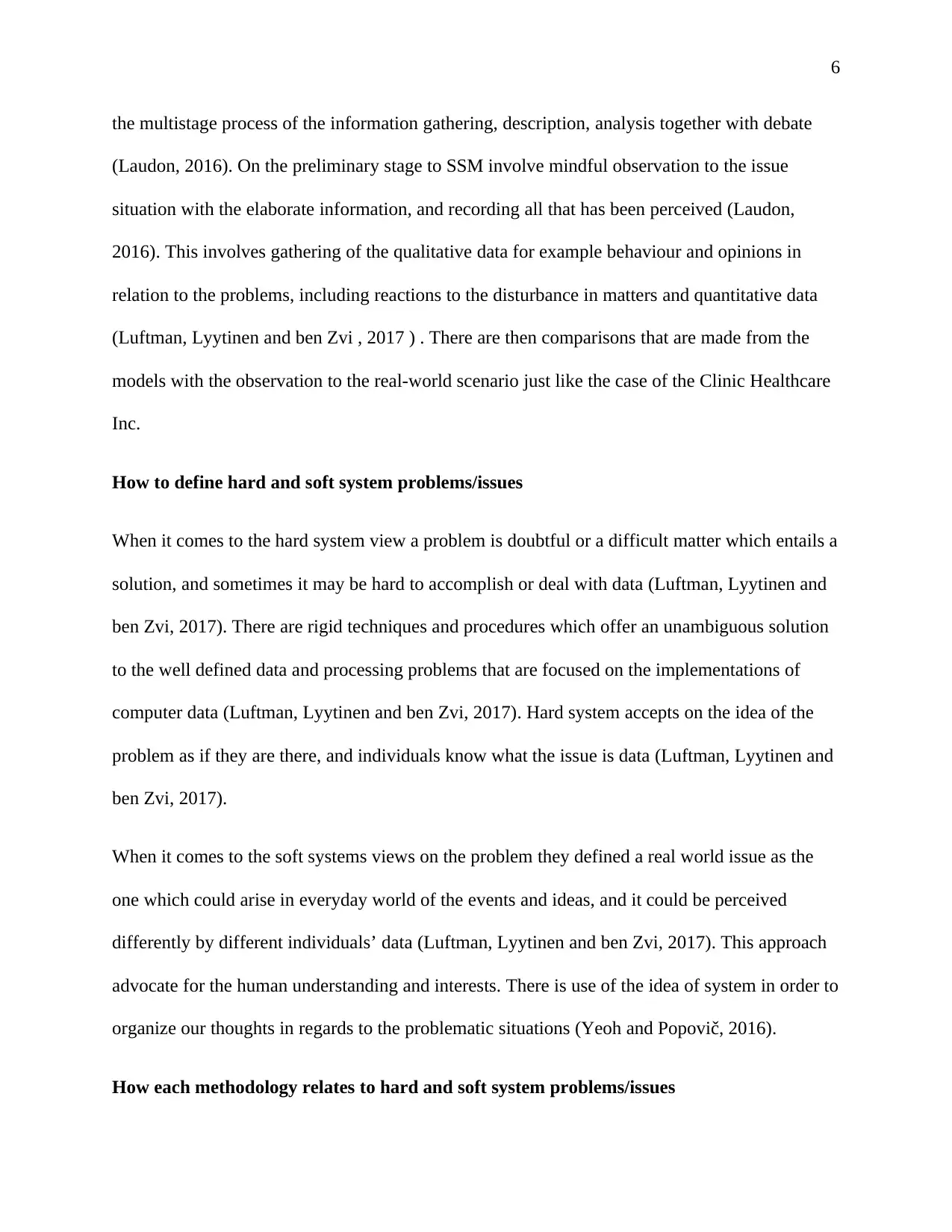
6
the multistage process of the information gathering, description, analysis together with debate
(Laudon, 2016). On the preliminary stage to SSM involve mindful observation to the issue
situation with the elaborate information, and recording all that has been perceived (Laudon,
2016). This involves gathering of the qualitative data for example behaviour and opinions in
relation to the problems, including reactions to the disturbance in matters and quantitative data
(Luftman, Lyytinen and ben Zvi , 2017 ) . There are then comparisons that are made from the
models with the observation to the real-world scenario just like the case of the Clinic Healthcare
Inc.
How to define hard and soft system problems/issues
When it comes to the hard system view a problem is doubtful or a difficult matter which entails a
solution, and sometimes it may be hard to accomplish or deal with data (Luftman, Lyytinen and
ben Zvi, 2017). There are rigid techniques and procedures which offer an unambiguous solution
to the well defined data and processing problems that are focused on the implementations of
computer data (Luftman, Lyytinen and ben Zvi, 2017). Hard system accepts on the idea of the
problem as if they are there, and individuals know what the issue is data (Luftman, Lyytinen and
ben Zvi, 2017).
When it comes to the soft systems views on the problem they defined a real world issue as the
one which could arise in everyday world of the events and ideas, and it could be perceived
differently by different individuals’ data (Luftman, Lyytinen and ben Zvi, 2017). This approach
advocate for the human understanding and interests. There is use of the idea of system in order to
organize our thoughts in regards to the problematic situations (Yeoh and Popovič, 2016).
How each methodology relates to hard and soft system problems/issues
the multistage process of the information gathering, description, analysis together with debate
(Laudon, 2016). On the preliminary stage to SSM involve mindful observation to the issue
situation with the elaborate information, and recording all that has been perceived (Laudon,
2016). This involves gathering of the qualitative data for example behaviour and opinions in
relation to the problems, including reactions to the disturbance in matters and quantitative data
(Luftman, Lyytinen and ben Zvi , 2017 ) . There are then comparisons that are made from the
models with the observation to the real-world scenario just like the case of the Clinic Healthcare
Inc.
How to define hard and soft system problems/issues
When it comes to the hard system view a problem is doubtful or a difficult matter which entails a
solution, and sometimes it may be hard to accomplish or deal with data (Luftman, Lyytinen and
ben Zvi, 2017). There are rigid techniques and procedures which offer an unambiguous solution
to the well defined data and processing problems that are focused on the implementations of
computer data (Luftman, Lyytinen and ben Zvi, 2017). Hard system accepts on the idea of the
problem as if they are there, and individuals know what the issue is data (Luftman, Lyytinen and
ben Zvi, 2017).
When it comes to the soft systems views on the problem they defined a real world issue as the
one which could arise in everyday world of the events and ideas, and it could be perceived
differently by different individuals’ data (Luftman, Lyytinen and ben Zvi, 2017). This approach
advocate for the human understanding and interests. There is use of the idea of system in order to
organize our thoughts in regards to the problematic situations (Yeoh and Popovič, 2016).
How each methodology relates to hard and soft system problems/issues
⊘ This is a preview!⊘
Do you want full access?
Subscribe today to unlock all pages.

Trusted by 1+ million students worldwide
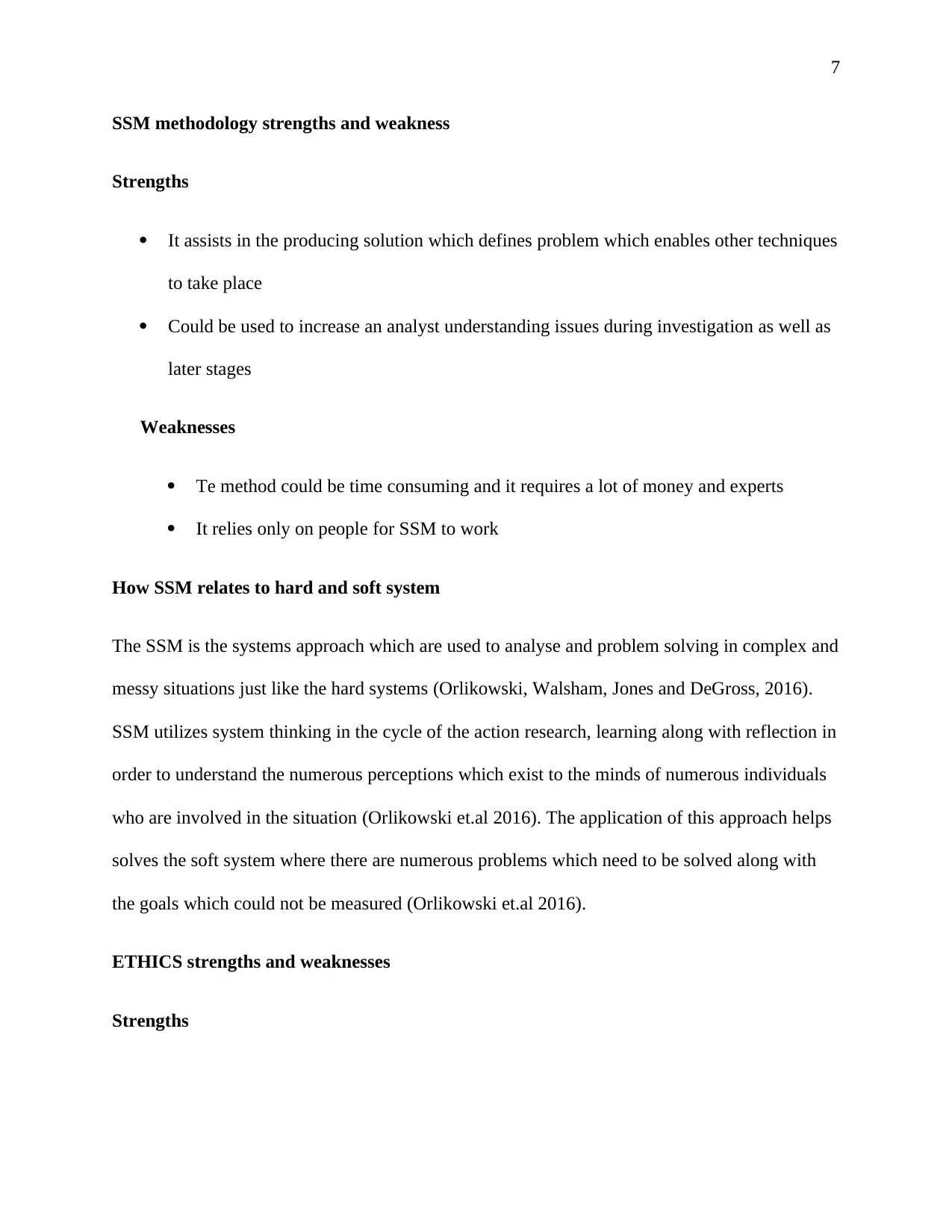
7
SSM methodology strengths and weakness
Strengths
It assists in the producing solution which defines problem which enables other techniques
to take place
Could be used to increase an analyst understanding issues during investigation as well as
later stages
Weaknesses
Te method could be time consuming and it requires a lot of money and experts
It relies only on people for SSM to work
How SSM relates to hard and soft system
The SSM is the systems approach which are used to analyse and problem solving in complex and
messy situations just like the hard systems (Orlikowski, Walsham, Jones and DeGross, 2016).
SSM utilizes system thinking in the cycle of the action research, learning along with reflection in
order to understand the numerous perceptions which exist to the minds of numerous individuals
who are involved in the situation (Orlikowski et.al 2016). The application of this approach helps
solves the soft system where there are numerous problems which need to be solved along with
the goals which could not be measured (Orlikowski et.al 2016).
ETHICS strengths and weaknesses
Strengths
SSM methodology strengths and weakness
Strengths
It assists in the producing solution which defines problem which enables other techniques
to take place
Could be used to increase an analyst understanding issues during investigation as well as
later stages
Weaknesses
Te method could be time consuming and it requires a lot of money and experts
It relies only on people for SSM to work
How SSM relates to hard and soft system
The SSM is the systems approach which are used to analyse and problem solving in complex and
messy situations just like the hard systems (Orlikowski, Walsham, Jones and DeGross, 2016).
SSM utilizes system thinking in the cycle of the action research, learning along with reflection in
order to understand the numerous perceptions which exist to the minds of numerous individuals
who are involved in the situation (Orlikowski et.al 2016). The application of this approach helps
solves the soft system where there are numerous problems which need to be solved along with
the goals which could not be measured (Orlikowski et.al 2016).
ETHICS strengths and weaknesses
Strengths
Paraphrase This Document
Need a fresh take? Get an instant paraphrase of this document with our AI Paraphraser
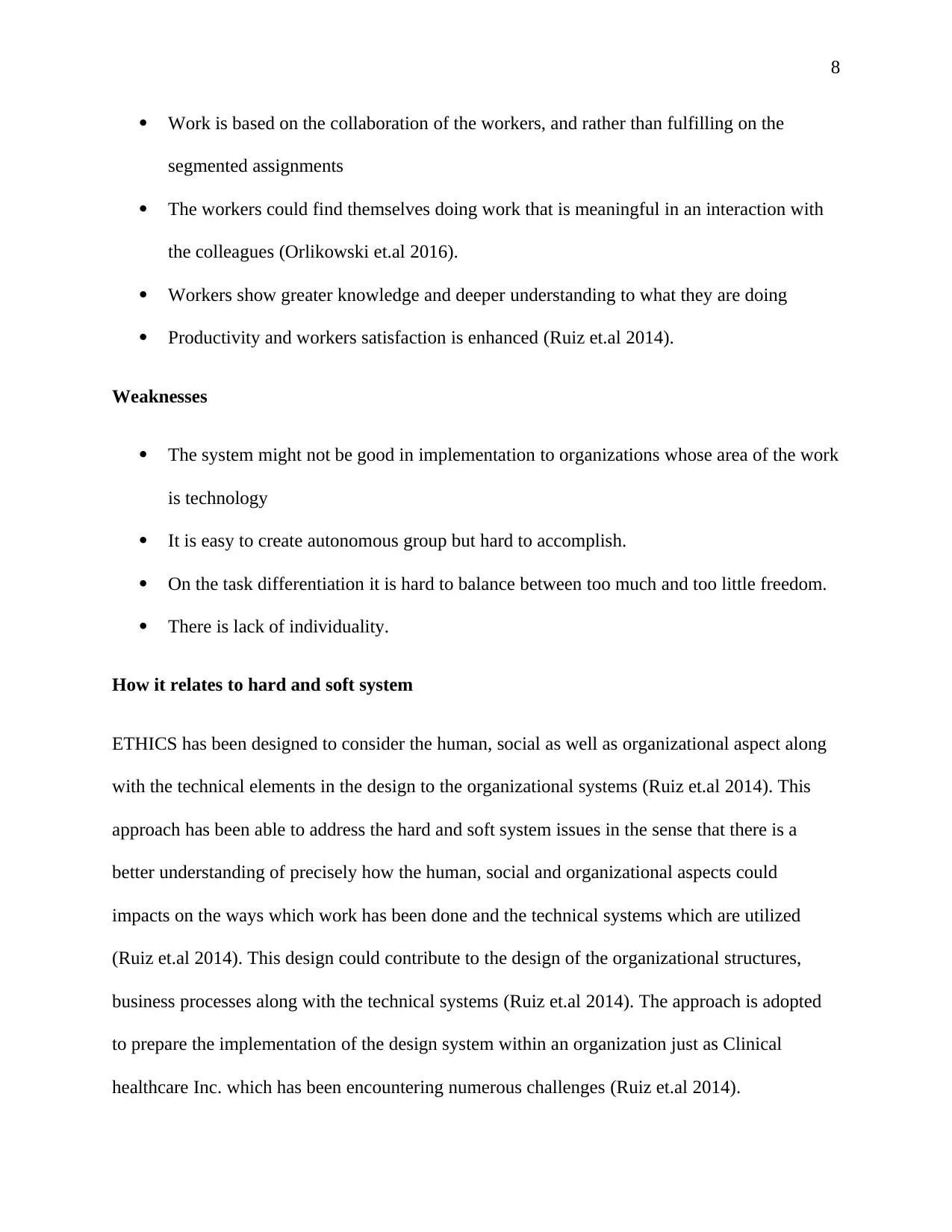
8
Work is based on the collaboration of the workers, and rather than fulfilling on the
segmented assignments
The workers could find themselves doing work that is meaningful in an interaction with
the colleagues (Orlikowski et.al 2016).
Workers show greater knowledge and deeper understanding to what they are doing
Productivity and workers satisfaction is enhanced (Ruiz et.al 2014).
Weaknesses
The system might not be good in implementation to organizations whose area of the work
is technology
It is easy to create autonomous group but hard to accomplish.
On the task differentiation it is hard to balance between too much and too little freedom.
There is lack of individuality.
How it relates to hard and soft system
ETHICS has been designed to consider the human, social as well as organizational aspect along
with the technical elements in the design to the organizational systems (Ruiz et.al 2014). This
approach has been able to address the hard and soft system issues in the sense that there is a
better understanding of precisely how the human, social and organizational aspects could
impacts on the ways which work has been done and the technical systems which are utilized
(Ruiz et.al 2014). This design could contribute to the design of the organizational structures,
business processes along with the technical systems (Ruiz et.al 2014). The approach is adopted
to prepare the implementation of the design system within an organization just as Clinical
healthcare Inc. which has been encountering numerous challenges (Ruiz et.al 2014).
Work is based on the collaboration of the workers, and rather than fulfilling on the
segmented assignments
The workers could find themselves doing work that is meaningful in an interaction with
the colleagues (Orlikowski et.al 2016).
Workers show greater knowledge and deeper understanding to what they are doing
Productivity and workers satisfaction is enhanced (Ruiz et.al 2014).
Weaknesses
The system might not be good in implementation to organizations whose area of the work
is technology
It is easy to create autonomous group but hard to accomplish.
On the task differentiation it is hard to balance between too much and too little freedom.
There is lack of individuality.
How it relates to hard and soft system
ETHICS has been designed to consider the human, social as well as organizational aspect along
with the technical elements in the design to the organizational systems (Ruiz et.al 2014). This
approach has been able to address the hard and soft system issues in the sense that there is a
better understanding of precisely how the human, social and organizational aspects could
impacts on the ways which work has been done and the technical systems which are utilized
(Ruiz et.al 2014). This design could contribute to the design of the organizational structures,
business processes along with the technical systems (Ruiz et.al 2014). The approach is adopted
to prepare the implementation of the design system within an organization just as Clinical
healthcare Inc. which has been encountering numerous challenges (Ruiz et.al 2014).
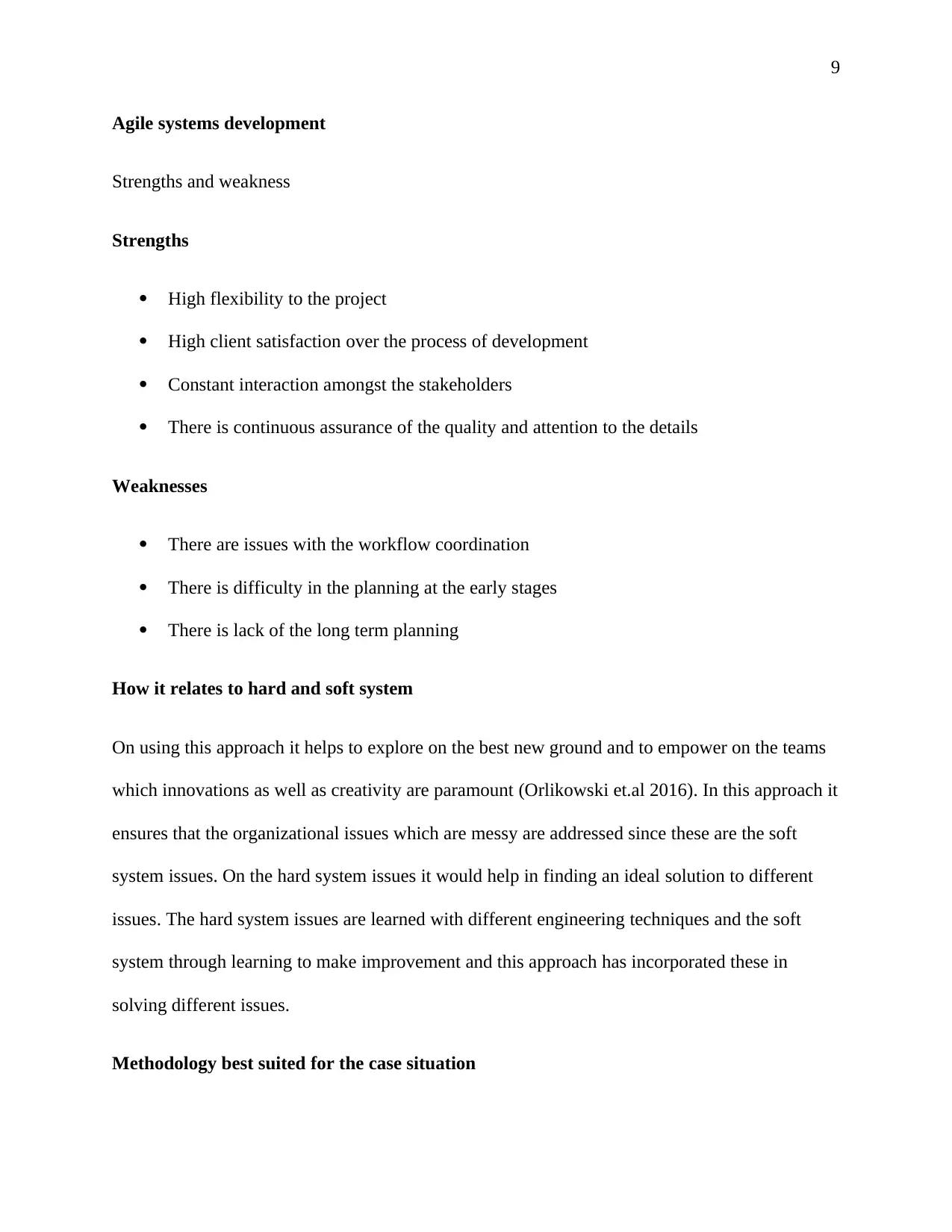
9
Agile systems development
Strengths and weakness
Strengths
High flexibility to the project
High client satisfaction over the process of development
Constant interaction amongst the stakeholders
There is continuous assurance of the quality and attention to the details
Weaknesses
There are issues with the workflow coordination
There is difficulty in the planning at the early stages
There is lack of the long term planning
How it relates to hard and soft system
On using this approach it helps to explore on the best new ground and to empower on the teams
which innovations as well as creativity are paramount (Orlikowski et.al 2016). In this approach it
ensures that the organizational issues which are messy are addressed since these are the soft
system issues. On the hard system issues it would help in finding an ideal solution to different
issues. The hard system issues are learned with different engineering techniques and the soft
system through learning to make improvement and this approach has incorporated these in
solving different issues.
Methodology best suited for the case situation
Agile systems development
Strengths and weakness
Strengths
High flexibility to the project
High client satisfaction over the process of development
Constant interaction amongst the stakeholders
There is continuous assurance of the quality and attention to the details
Weaknesses
There are issues with the workflow coordination
There is difficulty in the planning at the early stages
There is lack of the long term planning
How it relates to hard and soft system
On using this approach it helps to explore on the best new ground and to empower on the teams
which innovations as well as creativity are paramount (Orlikowski et.al 2016). In this approach it
ensures that the organizational issues which are messy are addressed since these are the soft
system issues. On the hard system issues it would help in finding an ideal solution to different
issues. The hard system issues are learned with different engineering techniques and the soft
system through learning to make improvement and this approach has incorporated these in
solving different issues.
Methodology best suited for the case situation
⊘ This is a preview!⊘
Do you want full access?
Subscribe today to unlock all pages.

Trusted by 1+ million students worldwide
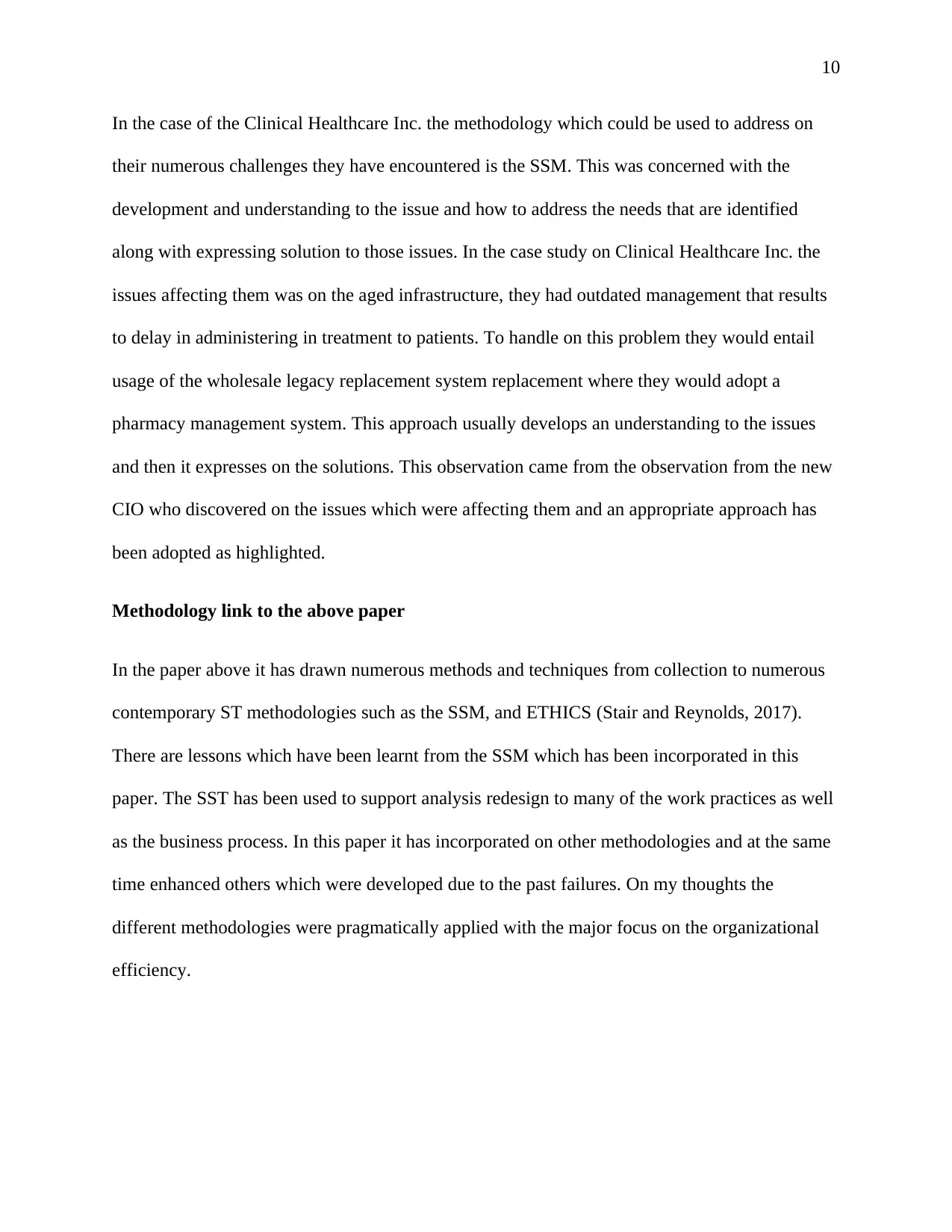
10
In the case of the Clinical Healthcare Inc. the methodology which could be used to address on
their numerous challenges they have encountered is the SSM. This was concerned with the
development and understanding to the issue and how to address the needs that are identified
along with expressing solution to those issues. In the case study on Clinical Healthcare Inc. the
issues affecting them was on the aged infrastructure, they had outdated management that results
to delay in administering in treatment to patients. To handle on this problem they would entail
usage of the wholesale legacy replacement system replacement where they would adopt a
pharmacy management system. This approach usually develops an understanding to the issues
and then it expresses on the solutions. This observation came from the observation from the new
CIO who discovered on the issues which were affecting them and an appropriate approach has
been adopted as highlighted.
Methodology link to the above paper
In the paper above it has drawn numerous methods and techniques from collection to numerous
contemporary ST methodologies such as the SSM, and ETHICS (Stair and Reynolds, 2017).
There are lessons which have been learnt from the SSM which has been incorporated in this
paper. The SST has been used to support analysis redesign to many of the work practices as well
as the business process. In this paper it has incorporated on other methodologies and at the same
time enhanced others which were developed due to the past failures. On my thoughts the
different methodologies were pragmatically applied with the major focus on the organizational
efficiency.
In the case of the Clinical Healthcare Inc. the methodology which could be used to address on
their numerous challenges they have encountered is the SSM. This was concerned with the
development and understanding to the issue and how to address the needs that are identified
along with expressing solution to those issues. In the case study on Clinical Healthcare Inc. the
issues affecting them was on the aged infrastructure, they had outdated management that results
to delay in administering in treatment to patients. To handle on this problem they would entail
usage of the wholesale legacy replacement system replacement where they would adopt a
pharmacy management system. This approach usually develops an understanding to the issues
and then it expresses on the solutions. This observation came from the observation from the new
CIO who discovered on the issues which were affecting them and an appropriate approach has
been adopted as highlighted.
Methodology link to the above paper
In the paper above it has drawn numerous methods and techniques from collection to numerous
contemporary ST methodologies such as the SSM, and ETHICS (Stair and Reynolds, 2017).
There are lessons which have been learnt from the SSM which has been incorporated in this
paper. The SST has been used to support analysis redesign to many of the work practices as well
as the business process. In this paper it has incorporated on other methodologies and at the same
time enhanced others which were developed due to the past failures. On my thoughts the
different methodologies were pragmatically applied with the major focus on the organizational
efficiency.
Paraphrase This Document
Need a fresh take? Get an instant paraphrase of this document with our AI Paraphraser
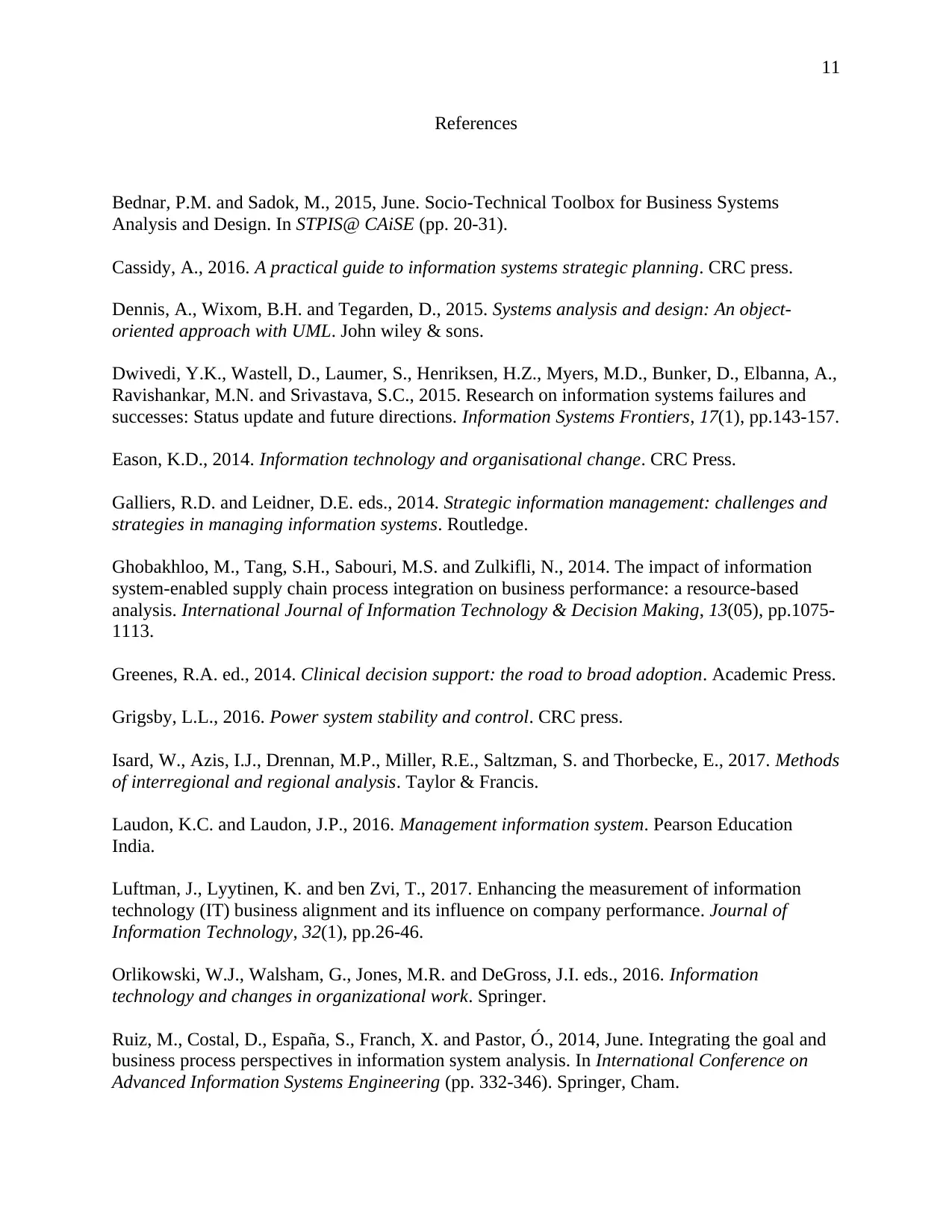
11
References
Bednar, P.M. and Sadok, M., 2015, June. Socio-Technical Toolbox for Business Systems
Analysis and Design. In STPIS@ CAiSE (pp. 20-31).
Cassidy, A., 2016. A practical guide to information systems strategic planning. CRC press.
Dennis, A., Wixom, B.H. and Tegarden, D., 2015. Systems analysis and design: An object-
oriented approach with UML. John wiley & sons.
Dwivedi, Y.K., Wastell, D., Laumer, S., Henriksen, H.Z., Myers, M.D., Bunker, D., Elbanna, A.,
Ravishankar, M.N. and Srivastava, S.C., 2015. Research on information systems failures and
successes: Status update and future directions. Information Systems Frontiers, 17(1), pp.143-157.
Eason, K.D., 2014. Information technology and organisational change. CRC Press.
Galliers, R.D. and Leidner, D.E. eds., 2014. Strategic information management: challenges and
strategies in managing information systems. Routledge.
Ghobakhloo, M., Tang, S.H., Sabouri, M.S. and Zulkifli, N., 2014. The impact of information
system-enabled supply chain process integration on business performance: a resource-based
analysis. International Journal of Information Technology & Decision Making, 13(05), pp.1075-
1113.
Greenes, R.A. ed., 2014. Clinical decision support: the road to broad adoption. Academic Press.
Grigsby, L.L., 2016. Power system stability and control. CRC press.
Isard, W., Azis, I.J., Drennan, M.P., Miller, R.E., Saltzman, S. and Thorbecke, E., 2017. Methods
of interregional and regional analysis. Taylor & Francis.
Laudon, K.C. and Laudon, J.P., 2016. Management information system. Pearson Education
India.
Luftman, J., Lyytinen, K. and ben Zvi, T., 2017. Enhancing the measurement of information
technology (IT) business alignment and its influence on company performance. Journal of
Information Technology, 32(1), pp.26-46.
Orlikowski, W.J., Walsham, G., Jones, M.R. and DeGross, J.I. eds., 2016. Information
technology and changes in organizational work. Springer.
Ruiz, M., Costal, D., España, S., Franch, X. and Pastor, Ó., 2014, June. Integrating the goal and
business process perspectives in information system analysis. In International Conference on
Advanced Information Systems Engineering (pp. 332-346). Springer, Cham.
References
Bednar, P.M. and Sadok, M., 2015, June. Socio-Technical Toolbox for Business Systems
Analysis and Design. In STPIS@ CAiSE (pp. 20-31).
Cassidy, A., 2016. A practical guide to information systems strategic planning. CRC press.
Dennis, A., Wixom, B.H. and Tegarden, D., 2015. Systems analysis and design: An object-
oriented approach with UML. John wiley & sons.
Dwivedi, Y.K., Wastell, D., Laumer, S., Henriksen, H.Z., Myers, M.D., Bunker, D., Elbanna, A.,
Ravishankar, M.N. and Srivastava, S.C., 2015. Research on information systems failures and
successes: Status update and future directions. Information Systems Frontiers, 17(1), pp.143-157.
Eason, K.D., 2014. Information technology and organisational change. CRC Press.
Galliers, R.D. and Leidner, D.E. eds., 2014. Strategic information management: challenges and
strategies in managing information systems. Routledge.
Ghobakhloo, M., Tang, S.H., Sabouri, M.S. and Zulkifli, N., 2014. The impact of information
system-enabled supply chain process integration on business performance: a resource-based
analysis. International Journal of Information Technology & Decision Making, 13(05), pp.1075-
1113.
Greenes, R.A. ed., 2014. Clinical decision support: the road to broad adoption. Academic Press.
Grigsby, L.L., 2016. Power system stability and control. CRC press.
Isard, W., Azis, I.J., Drennan, M.P., Miller, R.E., Saltzman, S. and Thorbecke, E., 2017. Methods
of interregional and regional analysis. Taylor & Francis.
Laudon, K.C. and Laudon, J.P., 2016. Management information system. Pearson Education
India.
Luftman, J., Lyytinen, K. and ben Zvi, T., 2017. Enhancing the measurement of information
technology (IT) business alignment and its influence on company performance. Journal of
Information Technology, 32(1), pp.26-46.
Orlikowski, W.J., Walsham, G., Jones, M.R. and DeGross, J.I. eds., 2016. Information
technology and changes in organizational work. Springer.
Ruiz, M., Costal, D., España, S., Franch, X. and Pastor, Ó., 2014, June. Integrating the goal and
business process perspectives in information system analysis. In International Conference on
Advanced Information Systems Engineering (pp. 332-346). Springer, Cham.
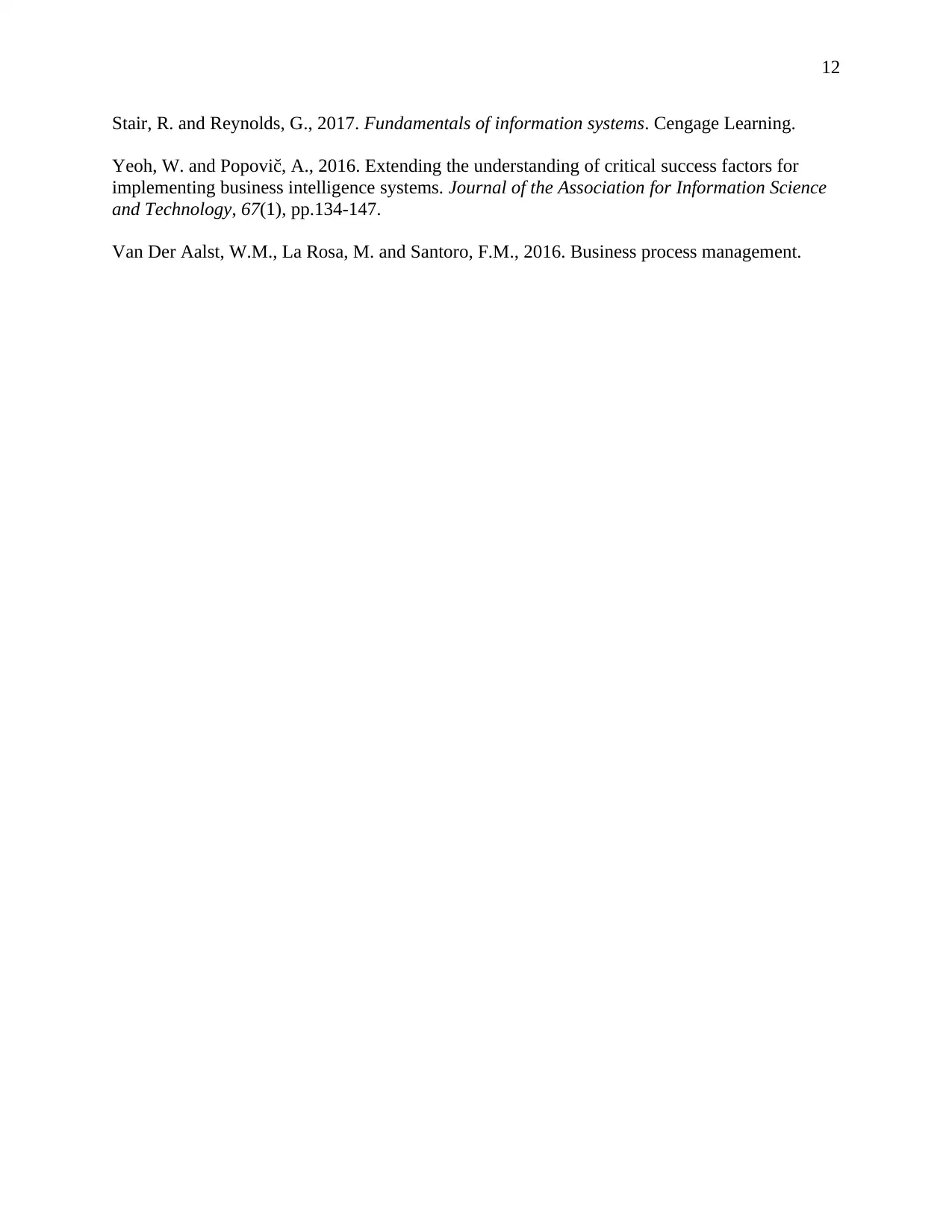
12
Stair, R. and Reynolds, G., 2017. Fundamentals of information systems. Cengage Learning.
Yeoh, W. and Popovič, A., 2016. Extending the understanding of critical success factors for
implementing business intelligence systems. Journal of the Association for Information Science
and Technology, 67(1), pp.134-147.
Van Der Aalst, W.M., La Rosa, M. and Santoro, F.M., 2016. Business process management.
Stair, R. and Reynolds, G., 2017. Fundamentals of information systems. Cengage Learning.
Yeoh, W. and Popovič, A., 2016. Extending the understanding of critical success factors for
implementing business intelligence systems. Journal of the Association for Information Science
and Technology, 67(1), pp.134-147.
Van Der Aalst, W.M., La Rosa, M. and Santoro, F.M., 2016. Business process management.
⊘ This is a preview!⊘
Do you want full access?
Subscribe today to unlock all pages.

Trusted by 1+ million students worldwide
1 out of 12
Related Documents
Your All-in-One AI-Powered Toolkit for Academic Success.
+13062052269
info@desklib.com
Available 24*7 on WhatsApp / Email
![[object Object]](/_next/static/media/star-bottom.7253800d.svg)
Unlock your academic potential
Copyright © 2020–2025 A2Z Services. All Rights Reserved. Developed and managed by ZUCOL.


